With the right Android applications, your Galaxy S10 phone can do the following:
- Automatically find your location on a map.
- Give directions to where you want to go.
- As you drive, using historical driving times.
- As you drive, using real-time road conditions.
- While you walk.
- As you take public transportation.
- Give turn-by-turn directions as you travel.
- With two-dimensional representations of the road and intersections.
- With three-dimensional representations of the roads, buildings, and intersections.
- Tell others where you are.
- Use the screen on your phone as a viewfinder to identify landmarks as you pan the area (augmented reality).
GPS 101: first things first
You can’t talk smartphone mapping without GPS in the background, which creates a few inherent challenges of which you need to be aware. First off (and obviously), there is a GPS receiver in your phone. That means the following:- Gimme a sec. Like all GPS receivers, your location-detection system takes a little time to determine your location when you first turn on your phone.
- Outdoors is better. Many common places where you use your phone — primarily, within buildings — have poor GPS coverage.
- Nothing is perfect. Even with good GPS coverage, location and mapping aren’t perfected yet. Augmented reality, the option that identifies local landmarks on the screen, is even less perfect.
- You must be putting me on. Your GPS receiver must be turned on for it to work. Sure, turning it off saves battery life, but doing so precludes mapping applications from working.
- Keep it on the down-low. Sharing sensitive location information is of grave concern to privacy advocates. The fear is that a stalker or other villain can access your location information in your phone to track your movements. In practice, there are easier ways to accomplish this goal, but controlling who knows your location is still something you should consider, particularly when you have applications that share your location information.
Good cellular coverage has nothing to do with GPS coverage. The GPS receiver in your phone is looking for satellites; cellular coverage is based upon antennas mounted on towers or tall buildings.
Mapping apps are useful, but they also use more battery life and data than many other applications. Be aware of the impact on your data usage and battery life. Leaving mapping applications active is convenient, but it can also be a drain on your battery and your wallet if you don’t pay attention to your usage and have the wrong service plan.
Practically speaking: using Maps
The kind of mapping application that’s easiest to understand is one that presents a local map when you open the application. Depending on the model of your phone, you may have a mapping applications preloaded, such as Google Maps, TeleNav, or VZ Navigator. You can find them on your Home screen and in your Application list.It’s not a large leap for a smartphone to offer directions from your GPS-derived location to somewhere you want to go in the local area. These are standard capabilities found in each of these applications.
This article describes Google Maps and Google Maps Navigation; these are both free and may come preinstalled on your phone. If not, you can download them from the Google Play Store. Other mapping applications that may come with your phone, such as Bing Maps or Waze, have similar capabilities, but the details will be a bit different. Or you may want to use other mapping applications. That’s all fine.
In addition to the general-purpose mapping applications that come on your phone, hundreds of available mapping applications can help you find a favorite store, navigate waterways, or find your car in a crowded parking lot. For example, Navigon and Waze offer solutions that base their navigation on real-time traffic conditions and give you turn-by-turn directions using three-dimensional images of the neighborhoods in which you are driving.As nice as mapping devices are, they’re too slow to tell you to stop looking at them and avoid an oncoming car. If you can’t control yourself in the car and need to watch the arrow on the map screen move, do yourself a favor and let someone else drive. If no one else is available to drive, be safe and don’t use the navigation service on your phone in the car.
The most basic way to use a map is to bring up the Google Maps application. The icon for launching this app is shown here.
The first screen that you see when you tap the Google Maps icon is a street map with your location. The following figure shows an example of a map when the phone user is in the Seattle area.
 You start where you are.
You start where you are.Your location is the blue dot at the center of the map — unless you’re moving, at which point it becomes a blue arrow. The resolution of the map in the figure starts at about one square mile. You can see other parts of the map by placing a finger on the map and dragging away from the part of the map that you want to see. That brings new sections of the map onto the screen.
Turn the phone to change how the map is displayed. Depending on what you’re looking for, a different orientation might be easier.
Changing map scale
A resolution of one square mile will work, under some circumstances, to help you get oriented in an unfamiliar place. But sometimes it helps to zoom out to get a broader perspective or zoom in to find familiar landmarks, like a body of water or a major highway.To get more real estate onto the screen, use a pinch motion. This shrinks the size of the map and brings in more of the map around where you’re pinching. If you need more real estate on the screen, you can keep pinching until you get more and more map. After you have your bearings, you can return to the original resolution by double-tapping the screen.
On the other hand, a scale of one square mile may not be enough. To see more landmarks, use the stretch motion to zoom in. The stretch motion expands the boundaries of the place where you start the screen. Continue stretching and stretching until you get the detail that you want. The following figure shows a street map both zoomed in and zoomed out. The map on the left is zoomed in in Satellite view. The map on the right is zoomed out in Terrain view.
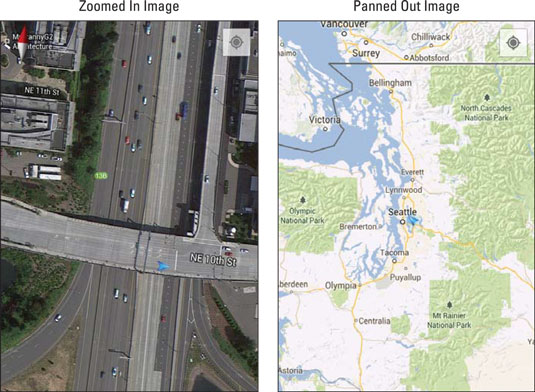 A street image zoomed in and zoomed out.
A street image zoomed in and zoomed out.The app gives you the choice of Satellite view or Terrain view by tapping the menu button, the three parallel lines, on the top-left corner of the map. This brings up a pop-up menu similar to the one shown.
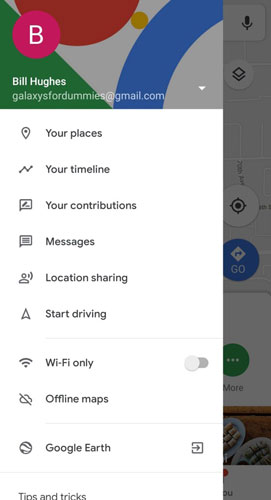 The Map menu pop-up.
The Map menu pop-up.Bring up the Satellite view by tapping Satellite. You get the Terrain view by tapping Terrain. You can also bring up other views that are useful to you, including transit routes and bicycling paths.
If you’re zooming in and can’t find where you are on the map, tap the dot-surrounded-by-a-circle icon. It moves the map so that you’re in the center.
Finding nearby services
Most searches for services fall into a relatively few categories. Your Maps application is set up to find what you’re most likely to seek. By tapping the Local Services icon at the bottom of the page, you’re offered a quick way to find the services near you, such as restaurants, coffee shops, bars, hotels, attractions, ATMs, and gas stations, as shown here.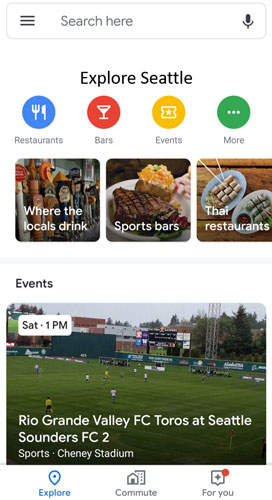 Tap to find a service on the map.
Tap to find a service on the map.Not only that, it is aware of the time of day. There are different suggestions during breakfast time than in the evening. Just scroll down and tap one of the topical icons, and your phone performs a search of businesses in your immediate area. The results come back as a regular Google search with names, addresses, and distances from your location. An example is shown here.
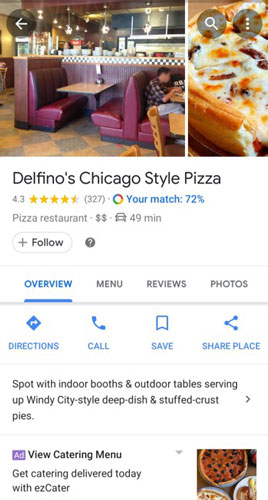 The results of a service selection.
The results of a service selection.In addition to the location and reviews, the search results include icons and other relevant information:
- Directions: Tap the car icon to get turn-by-turn directions from your location to this business.
- Call: Tap this to call the business.
- Save: Tap the star to set this place as one of your favorites.
- Website: Tap this to be taken to the website for this business.
- Share Place: Tap the Share Place icon, and you’re presented with lots of ways to tell your friends, family, co-workers, and the world about this wonderful place.
- More options, which include
- Street View: See the location in Google Street View. Street View shows a photo of the street address for the location you entered.
- Hours: If this establishment has shared its hours of operation, you can find them here.
- Menu: If this establishment has shared its menu, you can find it here.
- Reviews: This includes all kinds of information about what people have experienced this location.
- More: Run another Google search on this business to get additional information, such as reviews from other parts of the web.
But let’s say you show up, and the line is out the door. It happens. All you need to do is tap the street address, and the local map will appear as shown. This map tells you all the locations around you so you can find another option.
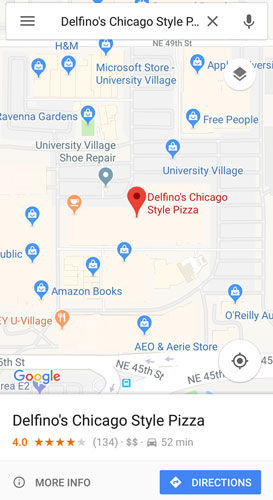 A street map search result.
A street map search result.How to get and use directions
You probably want to get directions from your map application. I know I do. You can get directions in a number of ways, including:- Tap the Search text box and enter the name or address of your location — for example, Seattle Space Needle or 742 Evergreen Terrace, Springfield, IL.
- Tap the Explore icon, tap the Attractions icon, and select your location.
It might seem intuitive to expect that when you search for a specific attraction (such as the Seattle Space Needle), you get only the Seattle Space Needle. Such a result, however, is sometimes too simple. A given search may have multiple results, such as for chain stores. Google Map gives you several choices, and you may need to choose your favorite. Typically, the app will give you the closest option.
To get directions, tap the Directions icon. This brings up the pop-up screen shown.
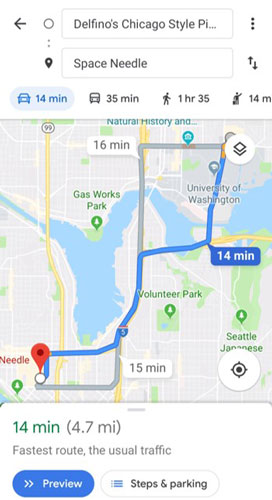 Your direction options, from original location to the target.
Your direction options, from original location to the target.This gives you the options of
- Driving: Turn-by-turn directions as you drive from where you are to the destination.
- Public Transportation: This option tells you how to get to your destination by taking public transportation using published schedules.
- Taxi or Ride Service: This option gives the time if you were to hop a taxi, Uber, or Lyft.
- Cycling: This option is for the cyclists among us; it includes bike trails in addition to city streets.
- Walking Navigation: Turn-by-turn directions as you walk to your destination.
- Get Directions: Sequential directions, as shown in the following figure, but without telling you when to turn.
- Navigate: Rather than show you a map, this option puts you in a navigation app that monitors where you are as you travel and tells you what to do next.
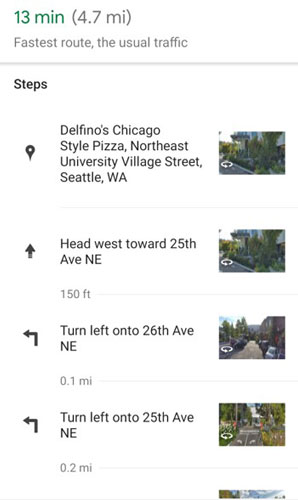 Step-by-step directions to the target.
Step-by-step directions to the target.




